FV510 Warrior
 United Kingdom (1984)
United Kingdom (1984)Infantry Fighting Vehicle and variants - 1043 total (as of 1995).
Development
The Warrior tracked vehicle family was originally developed to replace the FV430 series, basic APC of the British army, which lacked firepower. It was decided to create the first true Ingantry Fighting Vehicle of the British Army, wit the armament to match the requirements of the American Bradley. The Warrior started its development under the name MCV-80, for "Mechanised Combat Vehicle for the 1980s". One requirement was a top speed sufficient to keep up with the projected new Main Battle Tank 80, later cancelled and replaced by the Challenger 1. Indeed the FV430 family at that could not match its top speed. The project in fact started in 1972 and after submussion to different companies, GKN Defence won the contract in 1984. So at that point, it was ongoing for twelve years, reminding the nearly twenty years of the Bradley development time, reflecting on the many-back and forth iterations between the various manufacturers, the commission, and varying requirements. However as soon as production was accepted, GKN quickly modified the vehicle for production and delivered the first pre-production models in November 1984. After official testings, it was accepted in servuce by the British Army. GKN Defence, part of Alvis plc, was later purchased by BAE Systems. Producton went on up to 1995, with a total of 789 FV510 and their variants for the British Army, and 254 more, of a modified version called "Desert Warrior" for the Kuwaiti Army. Since then, there has been many developements and prototypes, including modernization programs, such as Warrior Capability Sustainment Programme, suspended as of 2020 (see later).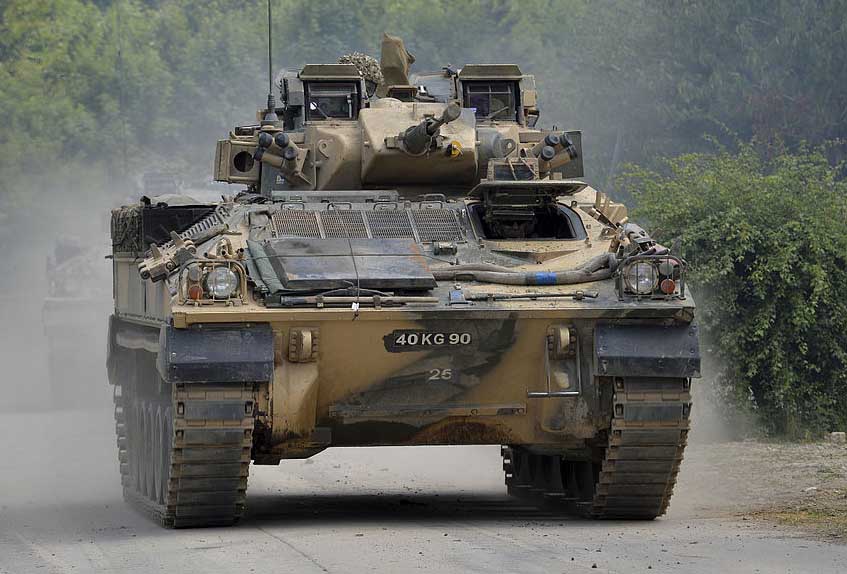
FV512 Warrior MCV on Salisbury plains - Exercise Lion Strike (MOD)
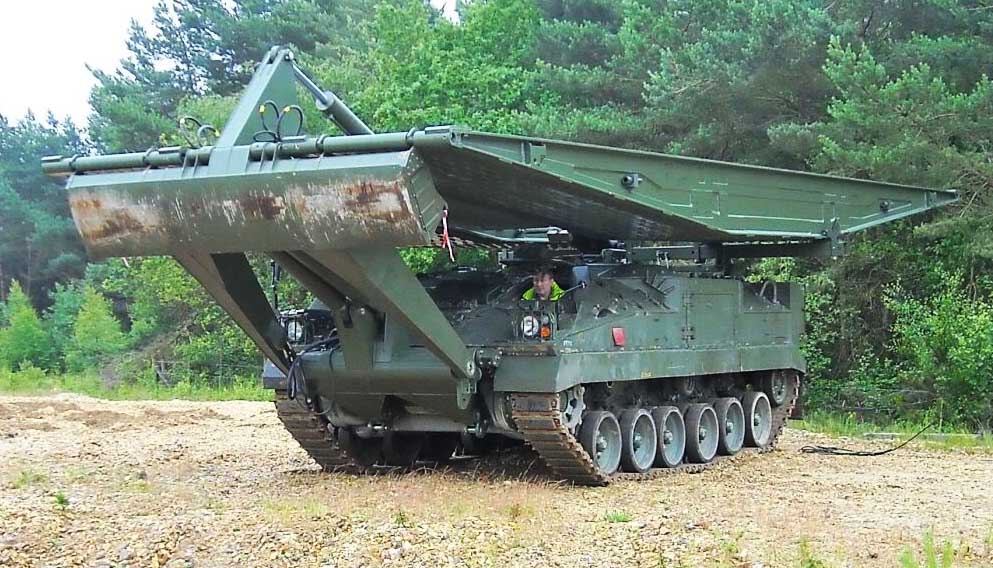
FV514 Engineers vehicle
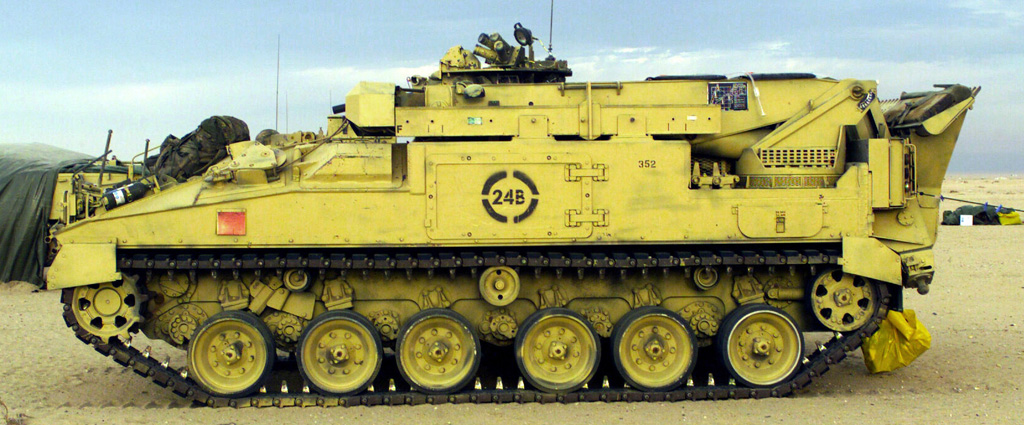
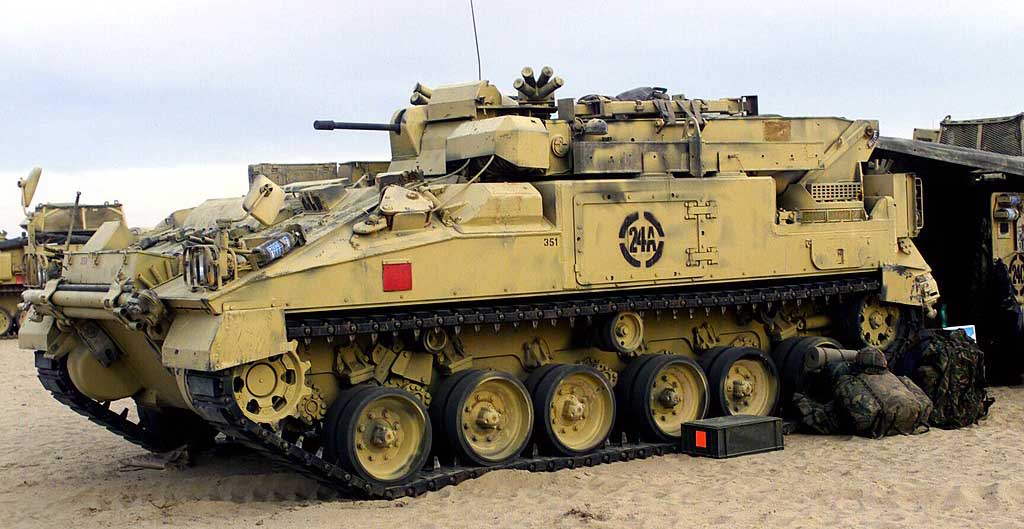
FV512 MCV Repair Vehicle in Iraq
Design of the Warrior
The Warrior incorporates design features deduced from reports of UK's battlefield experience. For example, firing ports were omitted from the design, as it was thought that the role or an APC/IFV was to carry troops under protection, and on site bring out its own firepower as support after the troops disembarked (see protection). The forward right compartment houses the driver compartment, seated next to the transmission at his left, while the gunner and commander are both seated in the turret. The infantry is seated, facing each other in the rear compartment, up to seven men, fully equipped. They exit and access through the single electric ram powered back door. A unusual choice copared to standard drop-down ramp in comparable US vehicles such as the M113 and Bradley. The seven-strong infantry also had access to supplies and anti-tank weapons, all what is needed for thos section to fight for 48-hour on the battlefield, including in NBC conditions.The Section Vehicles were also equipped with Clansman radios, replaced in the 1990s by Bowman radios for better communications, and C&C. Also each Warrior comes with passive image intensifier night vision sights. More recently, from 2005 they gave way for the more modern Thales Optronics Battle Group Thermal Imaging or "BGTI", digital sights with day/night 8x magnification. 350 vehicles were so equipped by 2007.
Protection
The base armour relied on a frontal very pronounced sloped glacis, whereas the sides and rear are only slightly sloped, almost flat. It was designed to withstand damage from a airbone burst of a 6.1 in (155 mm) projectile at 32 feet+ and direct fire from large caliber machine guns such as AP rounds of the standard KSP 14.5mm, on the frontal arc, all-around protection against small arms adn shrapnells (grenades or shells). The belly could withstand small ground-based mines, 9 kgs, to an extent.That absence of firing ports had several advantages, notably NBC lining, but also allowing to fit additional appliqué armour which was planned for any extrernal operations (such as desert storm). At some point cage armour was used in Iraq and Afghanistan, and in 2007 evolved into the "Wrap Two" appliqué armour which increased effectiveness against improvised explosive devices (IEDs).
Mobility
The Warrior's forward left compartment houses a Perkins-Rolls-Royce V8 Condor engine, transmitting to front sprockets through a four-speed automatic gearbox. Top speed was 46 mph (74 km/h) and 50 kph off road for a total of 22hp/ton for the base version. To handle the most difficult terrains, it was given a set of six roadwheels and three return rollers per side, plus rear idler. Suspensions are of the torsion bar type with hydropneumatic dampers, and all this power is passed to the ground thanks to TR30 single pin tracks from Astrum. The forward hatch above the transmission and power pack can be removed and replaced in less than one hour by two men. Range was 410 miles (660 km). The Warrior is amphibious without preparation, fording 1,2 m of water. However it is too heavy to be carrier by air other than heavy lift aircrafts such as the C5.Armament
The vehicle's central position is occupied by a two-man GKN Sankey turret. Tailored for it, it is a two-man model armed with a non-stabilized L21A1 30 mm RARDEN cannon. The latter could destroy an APC at a maximum range of 1,500 metres (1,600 yd). It is complemented by the L94A1 EX-34 7.62 mm Hughes Helicopters coaxial chain gun. The turret also is framed by with two clusters of four defensive grenade launchers, for Visual and Infrared Screen Smoke or "VIRSS". The L21A1 30 mm RARDEN is a proven piece of ordnance, already used on the Scorpion and Sabre light tanks and Fox armoured car. It has a long recoil system to lower its force on the mounting and vehicle and with the minimum inboard length. This resulted in a smaller turret, smaller target. No gun gas escapes into the turret and spent cases are ejected forward. Each cartridge case measured 17 cm in length, based on the Hispano-Suiza 831-L round. It is unusual as it is loaded manually with three-round clips. Each is a single unit, a system identical to the Bofors 40 mm cannon's 5-round clips. However the magazine hold two of these clips at a time, allowing a six rounds burst. It has its own power source to relain operation even the vehicle has its engine stopped cold. There is also a manual traverse and elevation. The gun was designed and tested in the early 1970s by RSAF Enfield, incorporated by Royal Ordnance Factories in 1982, now, the Royal Ordnance, but privatised by British Aerospace (BAe) in 1987 and closed. Equipment and personal relocating to RO Nottingham. The gun unit was manufactured by BMARC from 1985, now part of BAE Systems Global Combat Systems Munitions.Variants of the 510 family
Standard Variants
FV510 IFV: In reality ISV in British nomenclature, for "Infantry Section Vehicle". Main version operated with 489 produced total, including 105 carrying ATGW teams using the MILAN and Javelin).FV511 ICV: Infantry Command Vehicle, 84 produced. Similar but with a more powerful radio and large turret whip antennae on either side.
FV512 MCV: Mechanised Combat Repair Vehicle. Used by REME detachments organic to Armoured Infantry battalions. Fitted with a 6.5-tonne crane mounted at the back and folded on the right side of the vehicle, and several power tools, and using a towed trailer carrying two spare power packs alternative to a single Challenger Tank power pack. 105 produced, deployed in several operations.
FV513 MRV: The Mechanised Recovery Vehicle, specialized for field Repairs. Also used by the REME, 20-tonne winch, 6.5-tonne crane, power tools and trailer. 39 produced.
FV514 MAOV: Mechanised Artillery Observation Vehicle. Operated by the Royal Artillery as an Artillery Observation Post Vehicle (OPV). Mast-mounted Surveillance and Target Acquisition Radar plus Position and Azimuth Determining System with Image Intensifying and Infra-Red vision. Armament is the remaining 7.62 mm MG, the 30 mm Rarden cannon is now a dummy, allowing to keep the IFV appearance. 52 produced.
FV515 BCV: Battery Command Vehicle, operated by the Royal Artillery. 19 produced.
Armoured Ambulance. Six FV510 had their armaments removed and the aft compartmet modified to hold stretchers. Tailored to be used in Afghanistan, Operation Herrick.
Export variants
Desert Warrior (Kuwait): An export version completed redesigned for operations in desertic climate. First big difference was the Delco turret (LAV-25) with the stabilised M242 Bushmaster 25 mm chain gun, also 7.62 mm coaxial MG and two Hughes TOW ATGM launchers mounted on either. In 1993, Kuwait purchased 254 of these.Swiss Warrior 2000 Version developed to answer open requirements of the Swiss Army but not chosen. All-welded aluminium hull and increased armour, digital FCS, revised engine, more powerful, proposed with the Delco turret alternative to the Land Systems Hagglunds E30 turret and in both, the Alliant Techsystems Bushmaster II Mk 44 30 mm cannon.
VERDI-2. A private venture proposal, the acronym stands for Vehicle Electronics Research Defence Initiative. It was a technology demonstrator based on the FV510 hull in 1993 fitted with the CTAi 40mm cannon, and eight Starstreak missiles in quad launchers, and ADAD system (used on the Stormer HVM).
The Warrior Capability Sustainment Programme
Post-production upgrades consisted in the mre capable Bowman Communications System, and Thales Battle Group Thermal Imaging night sights. A bigger upgrade programme was planned as to extend the Warrior's active life to 2040. The program was called the the Warrior Capability Sustainment Program, or WCSP, targeted the conversion of 380 Warriors. The initial upgrade package comprised the Warrior Modular Protection System (WMPS), and Warrior Enhanced Electronic Architecture (WEEA). 245 vehicles within woukd receive a new turret: The Warrior Lethality Improvement Program (WFLIP). The remainder (now called Armoured Battlefield Support Vehicles or ABSV), will have no turrets but the field repair and recovery package used on the FV512/513, with a winch and crane attachments. BAE Systems/Lockheed Martin competed for this program, Lockheed Martin's proposal was made on the existing Warrior turret. However BAE Systems proposed a brand new turret and in March 2011, after testings, the Army announced Lockheed Martin's proposal was whosen, notably because it slower cost. It was tasked of managing both the WFLIP and the FRES turrets. Both were however not funded and delayed or curtailed, until October 2011 as the MoD announced the program was to be limited to £1bn, still allowing the IFV to be active up to 2040 as scheduled and upgrade start scheduled for the Warriors by 2018.Under the WFLI program, most critical point is the manually-fed RARDEN cannon. The new turret mounts is to mount a stabilised 40 mm cannon by CTA International (and Anglo-French consortium already chosen for the Jaguar program. It is firing Cased telescoped ammunition, is belt-fed and is common with the Ajax. In March 2020, the MoD announced the Warrior CSP in "demonstration phase", showing its capabilities for planned missions. So far, the program cost has been £430m, but no service date set anthough testings should end in 2021, so ten years after launching it, and for twenty years service awfterwards. In June 2020, the House of Commons Defence Select Committee announced the program was late, with a £227 cost overrun.
Combat records
First large scale deployment was Operation Granby, the 1991 Gulf War (Operation desert Storm, 1991). Bosnia in 1994: Operation Grapple (United Nations duties in Bosnia with the UNPROFOR) and Operation Resolute (with IFOR (Implementation Force) in 1996. Operation Telic, the British forces operating in Iraq from 2003. Warriors received additional slat armor but they were ill-protected against IEDs. Operation Herrick, British deployment in Afghanistan, with ISAF. Two Warriors were destroyed during the First Gulf War (nine KIA, friendly fire incidents from an American A-10 Thunderbolt II). On 17 November 2008, two more in Afghanistan and Iraq. One more on 7 March 2012, in Helmand.Sources/Links about the Charioteer
The FV 510 Warrior on Wikipediaon ukarmedforcescommentary
model kit
On military factory
On army technology
Model kit - scalemates
https://commons.wikimedia.org/wiki/Category:FV510_Warrior
FV 4101 specifications |
|
| Dimensions | 28.87 x 10.17 x 8.53 ft (8.8 x 3.1 x 2.6 m) |
| Total weight, battle ready | 29 tons (63,841 lbs) |
| Crew | 4 (driver, commander, gunner, loader) |
| Propulsion | Rolls Royce Meteor 12-cylinder gasoline (600 hp) |
| Suspension | Improved Christie system |
| Speed (road) | 32 mph (52 km/h) |
| Range | 149 mi (240 km) |
| Armament | Main : 83.4 mm QF-20 pounder (3.3 in) Secondary: coaxial 7.62 mm (0.3 in) machine gun |
| Armor | 14-64 mm (0.55-2.52 in) |
| Total conversions | 200 to 442 in 1950-52 |
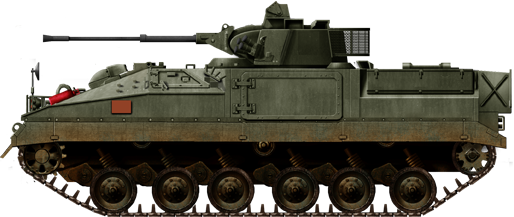
FV 510 Warrior, base IFV, in green factory livery.
MCV-80 camouflaged in exercizes, Salisbury Plains during Exercise Lion Strike. The latter was designed to test Majors from all trades across the Army in Command and Control scenarios. Were participating the 4 RIFLES from 1 Armoured Infantry Brigade, 1 YORKS, and the KRH in Challenger 2 Main Battle Tanks from 12 Armoured infantry Brigade. July 2014.
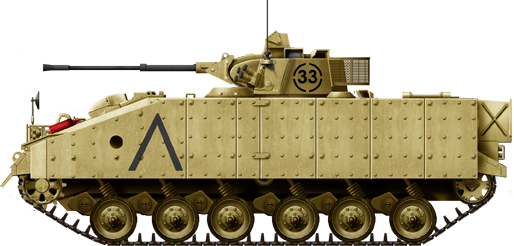
FV 510 Warrior in 1991, Operation desert Storm.
FV 510 Warrior in Iraq, 2004.
FV 512 .
FV 513 ,.
FV 414 .
FV 415

Cold War Tanks


































Cold war tanks posters

Cold War Main Battle Tanks

Cold War Soviet Army
Museums, Movies, Books & Games
The Tanks and Armor in pop culture
Tanks and armored vehicles in general are only really grasped when seen first person: The mass, the scale, it's all there. Explore also the way tanks were covered in the movie industry, in books and in video games.Movies:
Best tanks movie on warhistoryonline.com
On imdb.com
On bestsimilar.com/
miltours.com
liveabout.com/
watchmojo.com
Video Games:
pcgamesn.com
historyhit.com
levvvel.com
vg247.com/best-tank-games
mmobomb.com/
alienwarearena.com
